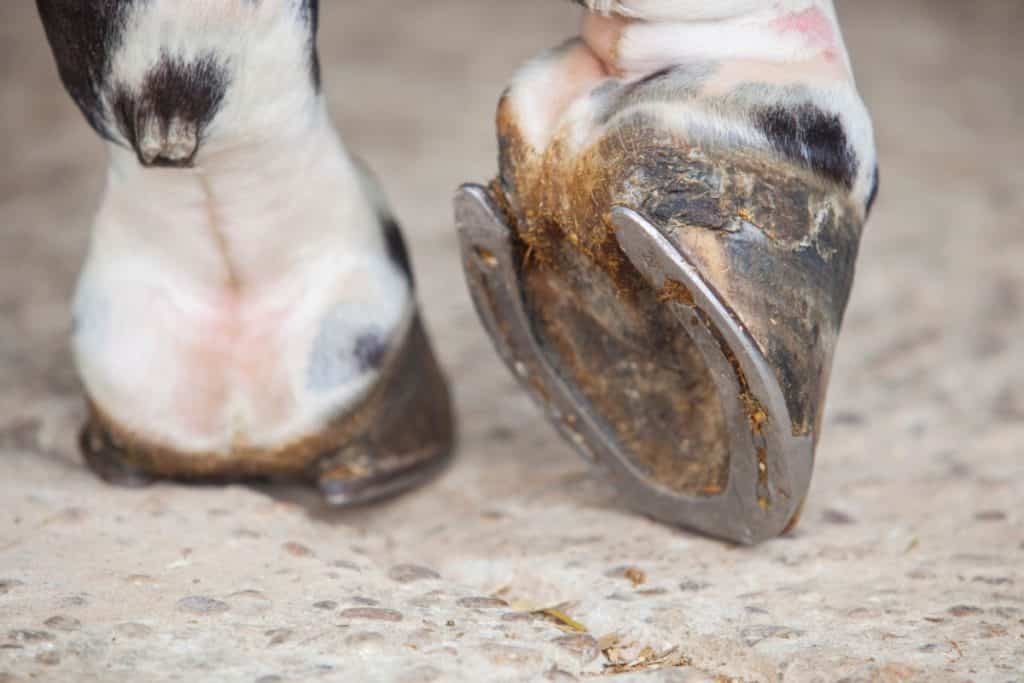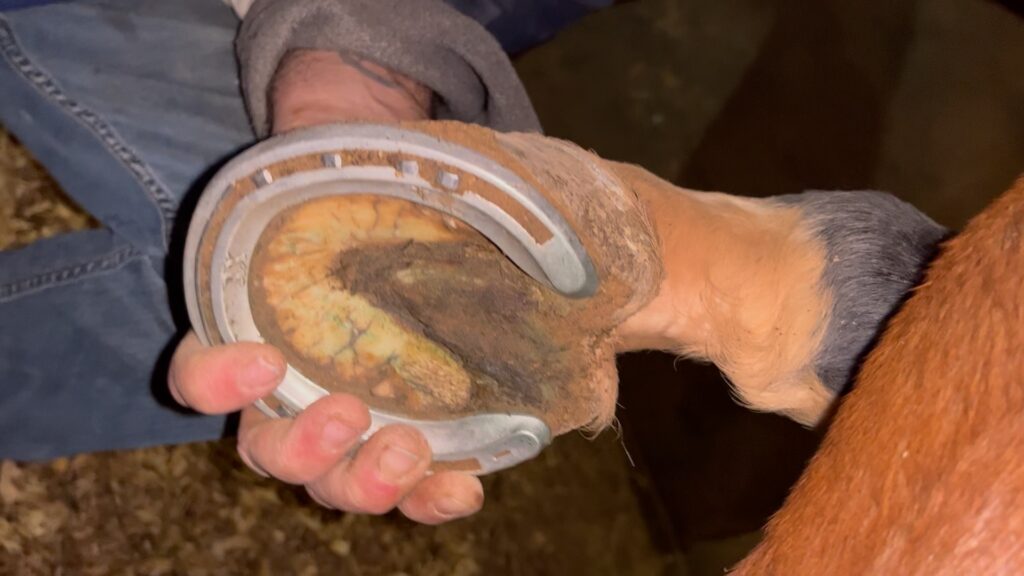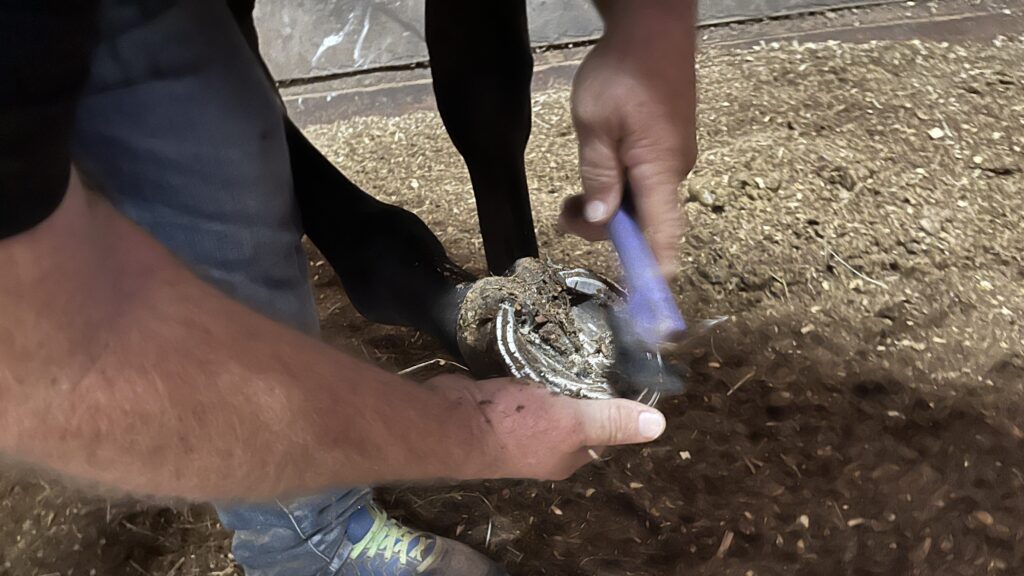Last updated: June 14, 2025
Any links on this page that lead to products on Amazon are affiliate links and I earn a commission if you make a purchase. Thanks in advance – I really appreciate it!
As a horse owner with six horses on regular shoeing schedules, I understand the challenges of determining how often to shoe your horse. While a general guideline is to have your horse’s hooves trimmed every 6-8 weeks and shod at the same time, each horse is unique. Hooves grow at different rates, requiring adjustments to their shoeing schedule. Sometimes, unexpected events like a lost shoe can throw off the schedule entirely.

The Vital Role of Hoof Care in Horse Health and Performance
Proper hoof care is crucial for your horse’s overall health and well-being. Healthy hooves provide support, balance, and shock absorption, allowing your horse to move comfortably and perform its best. Neglecting hoof care can lead to a range of problems, including lameness, pain, and even long-term damage.

Factors That Affect How Often Your Horse Needs Hoof Care
Several factors can influence how often your horse needs its hooves trimmed and shod:
- Horse’s Activity Level: Horses in heavy work, like performance horses, tend to wear their shoes faster and may need more frequent shoeing and trimming than those with lighter workloads or pasture pets.
- Hoof Growth Rate: Like humans, horses have different growth rates. Some horses’ hooves grow faster than others, requiring more frequent trims to maintain their optimal length and shape.
- Environment: The terrain your horse lives on and the climate can impact hoof wear and growth. Horses on hard or rocky terrain may wear their shoes faster, while those in wet or muddy environments may be more prone to hoof problems that require more frequent farrier attention.
- Shoeing: The type of shoes used and your horse’s needs can influence how often they need to be replaced. Some horses may need specialized shoes for specific activities or hoof conditions.

Recognizing When Your Horse Needs Hoof Attention
Regularly checking your horse’s hooves is essential to determine when they need attention. Here are some common signs:
- Overgrown Hooves: Long hooves can cause imbalances, making it difficult for your horse to move correctly and potentially leading to strain or injury.
- Cracked or Chipped Hooves: Cracks or chips in the hoof wall can provide entry points for bacteria and fungi, increasing the risk of infection and lameness.
- Loose or Missing Shoes: Loose shoes can cause discomfort and instability, while missing shoes leave the hoof vulnerable to damage.
- Changes in Gait or Stride: If your horse suddenly starts moving differently or appears lame, hoof problems could be the culprit.

The Impact of Poor Hoof Care: A Real-Life Example
I recently acquired a promising young filly who wasn’t living up to her potential on the track. After bringing her to my barn, we noticed her hooves were in a sorry state. Her heels had been trimmed too short, and the shoes were improperly nailed, causing discomfort and hindering her movement.
We worked with a skilled farrier to address these issues over a few weeks. The transformation was remarkable! With properly balanced hooves and correctly fitted shoes, the filly’s performance improved dramatically. She went on to win her next race, proving the direct link between hoof health and athletic success.
Step-by-Step: What to Expect During a Farrier Visit
A typical farrier visit involves:
- Assessing the hooves: The farrier will examine each hoof to assess its condition and any potential issues.
- Trimming the hooves: The farrier will carefully trim the hoof wall, sole, and frog to maintain proper balance and shape.
- Fitting and applying shoes (if needed): If your horse is shod, the farrier will shape and fit the shoes, then nail them securely to the hoof wall.
- Finishing touches: The farrier may make final adjustments to ensure the hooves are balanced and comfortable.
Finding a qualified and experienced farrier is crucial for your horse’s hoof health. The American Farrier’s Association (AFA) offers a helpful “Find a Farrier” tool on their website to help you locate a certified professional in your area.

Proactive Hoof Care: Tips for Horse Owners
In addition to regular farrier visits, you can take steps to promote healthy hooves:
- Regular cleaning: Remove dirt and debris from your horse’s hooves daily to prevent thrush and other infections.
- Proper diet: A balanced diet with adequate nutrients, including biotin, is essential for healthy hoof growth. The American Association of Equine Practitioners (AAEP) provides valuable information about proper nutrition for horses, including recommendations for supporting hoof growth.
- Pasture management: Rotate pastures to prevent overgrazing and avoid muddy conditions that can soften hooves and contribute to thrush.
How Horseshoes are Attached: The Farrier’s Expertise
Farriers keep a stock of commercial standard-sized metal horseshoes. With a lot of heat and a little hammering, shoes are customized to fit the horse’s feet. Once the shoe is sized correctly, the farrier drives nails up and through the shoe and into the horse’s hoof wall.
The portion of the nail tip that protrudes through the hoof wall is clipped and squeezed to secure it tightly to the hoof, called clinching. In general, the process of putting on horseshoes is painless when done by an experienced farrier.

Frequently Asked Questions About Horse Hoof Care
Are horseshoes lucky?
The horseshoe has been traditionally considered a symbol of good luck, especially in Western cultures. The origins of this belief are unclear, but it may be due to the horseshoe’s protective powers or its association with the moon, which is often linked to good fortune.
How many times can you reuse a horseshoe?
In general, horseshoes aren’t reused but replaced. However, they can be reused once or twice depending on various factors, including the type of shoe, the horse’s work, the terrain it covers, and the amount of wear and tear on the shoe.
Why Don’t Wild Horses Need Shoes?
Wild horses don’t need shoes because their feet evolved to adjust to the environment. It’s also likely genetically that they have superior feet to their domestic relatives because they’ve never worn shoes, and their constant movement over dry, rough terrain hardens their hooves.
Horses’ Hooves are used to Make Glue.
Hoof glue has been around for thousands of years. The keratin and collagen in a horse’s hoof make an excellent adhesive. Horse hooves were widely used in the past to make glue, and it is still used today in limited fashions, such as making fine cabinetry and other delicate woodworking projects.
Cost of Hoof Trimming and Shoeing
The cost of hoof trimming and shoeing can vary depending on several factors, including your location, the farrier’s experience, and the specific needs of your horse. In my area, prices typically range from $50 to $120 per horse.
Personally, I have a unique arrangement with my farrier, who is also a friend. His usual fee is $75, but we often trade work, hay, or feed for his services. This barter system works well for both of us, but it’s important to remember that not all farriers may be open to such arrangements.
Below is an informative YouTube video explaining why horses need shoes.
Conclusion: How Often Should You Shoe Your Horse?
Remember, each horse is unique, and their hoof care needs may vary. Work closely with your farrier to establish a personalized hoof care plan that ensures your horse’s hooves stay healthy and strong. The cost of hoof trimming and shoeing can vary depending on several factors, so be sure to discuss pricing and payment options with your farrier beforehand.
Have any questions about horse shoeing or hoof care? Share your thoughts and experiences in the comments below!

About the Author: Miles Henry
Lifelong Horseman | Racehorse Owner | Published Author
Miles Henry brings over 25 years of hands-on experience training and owning Thoroughbred racehorses. Raised with Quarter Horses and Appaloosas, he’s spent a lifetime learning from horses—on the track, in the barn, and in the field. Today, he runs a small but successful racing stable in Louisiana and shares real-world insights on HorseRacingSense.com, helping horse owners, fans, and bettors navigate the sport with confidence.
📚 Books: View Miles’s books on Amazon »
🎧 Podcast Guest: Animal Tales Ep. 32 |
YouTube Interview
📩 Newsletter: Sign up for racing tips and horse care advice »
🔗 Follow Miles:
Twitter |
Facebook |
YouTube


